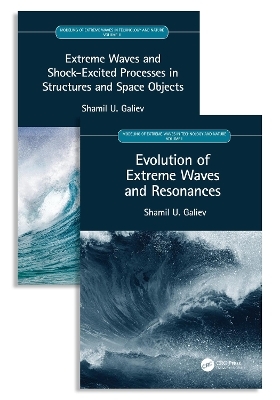
Modeling of Extreme Waves in Technology and Nature, Two Volume Set
CRC Press
978-1-138-47951-7 (ISBN)
- Titel z.Zt. nicht lieferbar
- Versandkostenfrei
- Auch auf Rechnung
- Artikel merken
Modeling of Extreme Waves in Technology and Nature is a two-volume set, comprising Evolution of Extreme Waves and Resonances (Volume I) and Extreme Waves and Shock-Excited Processes in Structures and Space Objects (Volume II).
The theory of waves is generalized on cases of extreme waves. The formation and propagation of extreme waves of various physical and mechanical nature (surface, elastoplastic, fracture, thermal, evaporation) in liquid and solid media, and in structural elements contacting with bubbly and cryogenic liquids are considered analytically and numerically. The occurrence of tsunamis, giant ocean waves, turbulence, and different particle-waves is described as resonant natural phenomena.
Nonstationary and periodic waves are considered using models of continuum. The change in the state of matter is taken into account using wide-range determining equations.
The desire for the simplest and at the same time general description of extreme wave phenomena that takes the reader to the latest achievements of science is the main thing that characterizes this book and is revolutionary for wave theory. A description of a huge number of observations, experimental data, and calculations is also given.
Shamil U. Galiev obtained his Ph.D. degree in Mathematics and Physics from Leningrad University in 1971, and, later, a full doctorate (ScD) in Engineering Mechanics from the Academy of Science of Ukraine (1978). He worked in the Academy of Science of former Soviet Union as a researcher, senior researcher and department chair from 1965 to 1995. From 1984 to 1989 he served as a Professor of Theoretical Mechanics in the Kiev Technical University, Ukraine. Since 1996 he has served as Professor, Honorary Academic of the University of Auckland, New Zealand. Dr. Galiev has published approximately 90 scientific publications, and is the author of seven books devoted to different complex wave phenomena. From 1965-2014 he has studied different engineering problems connected with dynamics and strength of submarines, rocket systems, and target/projectile (laser beam) systems. Some of these results were published in books and papers. During 1998-2017 he did extensive research and publication in the area of strongly nonlinear effects connected with catastrophic earthquakes, giant ocean waves and waves in nonlinear scalar fields. Overall, Dr. Galiev’s research has covered many areas of engineering, mechanics, physics and mathematics.
Volume 1: PART I. Basic equations and ideas. Chapter 1 Lagrangian description of surface water waves. Chapter 2 Euler’s figures and extreme waves: examples, equations and unified solutions. PART II. Waves in finite resonators. Chapter 3 Generalisation of the d’Alembert’s solution for nonlinear long waves. Chapter 4 Extreme resonant waves: a quadratic nonlinear theory. Chapter 5. Extreme resonant waves: a cubic nonlinear theory. Chapter 6 Spherical resonant waves. Chapter 7 Extreme Faraday waves. PART III. Extreme ocean waves and resonant phenomena. Chapter 8 Long waves, Green's law and topographical resonance. Chapter 9 Modelling of the tsunami described by Charles Darwin and coastal waves. Chapter 10. Theory of extreme (rogue, catastrophic) ocean waves. Chapter 11. Wind-induced waves and wind-wave resonance. Chapter 12. Transresonant evolution of Euler’s figures into vortices. PART IV. Modelling of particle-waves, slit experiments and the extreme waves in scalar fields. Chapter 13. Resonances, Euler figures, and particle-waves. Chapter 14. Nonlinear quantum waves in the light of recent slit experiments. Chapter 15. Resonant models of origin of particles and the Universe due to quantum perturbations of scalar fields. References.
Volume 2: PART I. Basic models, equations and ideas. Chapter 1. Models of continuum. Chapter 2. The dynamic destruction of some materials in tension waves. Chapter 3. Models of dynamic failure of weakly-cohesived media (WCM). PARTI II. Extreme waves and structural elements. Chapter 4. Extreme effects and waves in impact loaded hydrodeformable systems. Chapter 5. Shells and cavitation (cool boiling) waves. Chapter 6. Interaction of extreme underwater waves with structures. Part III. Counterintuitive behaviour (CIB) of structural elements after impact loads. Chapter 7. Experimental data. Chapter 8. CIB of plates and shallow shells: theory and calculations. Part IV. Extreme waves excited by impact of heat, radiation or mass. Chapter 9. Formation and amplification of heat waves. Chapter 10. Extreme waves excited by radiation. Chapter 11. The melting waves in front of a massive perforator.
| Erscheint lt. Verlag | 1.7.2020 |
|---|---|
| Reihe/Serie | Modeling of Extreme Waves in Technology and Nature |
| Zusatzinfo | 2 Tables, black and white; 20 Illustrations, color; 435 Illustrations, black and white |
| Verlagsort | London |
| Sprache | englisch |
| Maße | 156 x 234 mm |
| Gewicht | 1750 g |
| Themenwelt | Naturwissenschaften ► Geowissenschaften ► Hydrologie / Ozeanografie |
| Technik ► Maschinenbau | |
| Technik ► Umwelttechnik / Biotechnologie | |
| ISBN-10 | 1-138-47951-9 / 1138479519 |
| ISBN-13 | 978-1-138-47951-7 / 9781138479517 |
| Zustand | Neuware |
| Informationen gemäß Produktsicherheitsverordnung (GPSR) | |
| Haben Sie eine Frage zum Produkt? |